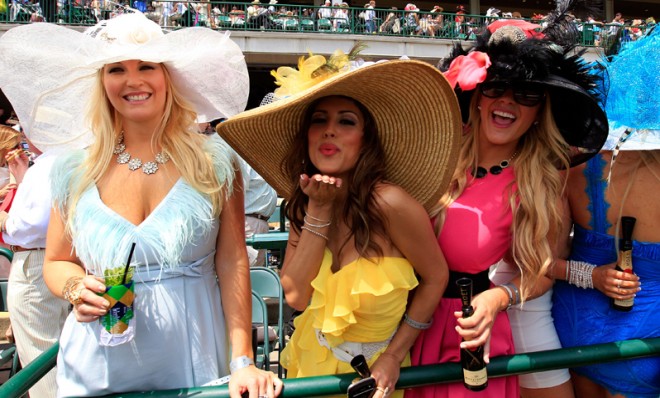The Kentucky Derby: A brief guide to hat-related words
Some would have you believe the Kentucky Derby is about horse-racing. We know it's really about the hats.


How would you describe one who is wearing a hat? You could say hat-wearing, or you could say galericulate, which means having a little galea, which is Latin for something helmet-shaped.
If you remove your hat to show respect, you're practicing hat-honor. The term was "used by the early Friends or Quakers, who refused to pay this token of respect." Along those same lines, to be unbonneted means to be without a bonnet but also "making no obeisance" or gesture of deference or honor.
Need to buy a hat? Visit a milliner, one who "makes, trims, designs, or sells hats." The word probably comes from the city Milan, once "the source of goods such as bonnets and lace." Or frequent a haberdasher, a seller of hats, men's furnishings, or "sewing notions and small wares." The word haberdasher may come from the Anglo-Norman hapertas, "petty wares."
The Week
Escape your echo chamber. Get the facts behind the news, plus analysis from multiple perspectives.

Sign up for The Week's Free Newsletters
From our morning news briefing to a weekly Good News Newsletter, get the best of The Week delivered directly to your inbox.
From our morning news briefing to a weekly Good News Newsletter, get the best of The Week delivered directly to your inbox.
Now to the starting line: Which came first, derby the hat or derby the race? The race did, according to the Oxford English Dictionary (OED). The annual horse race was founded in 1780 by the 12th Earl of Derby. The hat may have been named for the race "where this type of hat was worn." The derby is also known as a bowler, named for the hat's shape. Similar is the billycock, perhaps an alteration of bullycocked, "cocked in the fashion of a swashbuckler."
Picture-hats are the type favored at the Run for the Roses. Wide-brimmed and elaborately decorated, picture-hats were originally "supposed to be made in imitation of one shown in some striking portrait," hence the name. They were also known a gainsborough hats as these "striking portraits" were often done by English painter Thomas Gainsborough.
Kiss-me-quick! A command, yes, but also "a small becoming bonnet fashionable about the middle of the nineteenth century," or "a lady's cap with ribbons that tied under the chin on one side with 'kissing-strings'." Kiss-me-quick was also "a name given to various things of a presumably coquettish or attractive nature." Another kind of bonnet, the bongrace, was also a "shade formerly worn by women on the front of a bonnet to protect the complexion from the sun."
The cloche, a favorite among flappers, is a "close-fitting woman's hat with a bell-like shape." Cloche comes from an Old French word meaning "bell," and originally referred to a bell-shaped cover "used chiefly to protect plants from frost." The pillbox, popularized by Jackie Kennedy, is pillbox-shaped with its "upright sides and a flat crown." And we can only guess that the porkpie hatlooks like a porkpie.
A free daily email with the biggest news stories of the day – and the best features from TheWeek.com
The Dolly Varden, large and "overloaded with flowers," is named for a character "known for her colorful costume in the novel Barnaby Rudge by Charles Dickens." Dolly Varden also refers to "a woman's gown of gay-flowered material," as well as "a colorfully spotted trout." The hipster-topping fedora comes from a 19th century French play titled. "Fédora," in which "the heroine, Fédora Romanoff, wore a center-creased, soft brimmed hat."
The shady sombrero comes from the Spanish sombrar, "to shade," while the fascinator, a woman's "head decorator", both "delicate" and "often frivolous," is designed to fascinate. The fascinator made headlines in 2011 with its often fabulous appearance at the wedding of Prince William and Kate Middleton. The word fascinate ultimately comes from the Latin fascinum, "an evil spell."
That's just the tip of the hat iceberg. For even more kinds of hats, caps, and hoods, check out these lists, Headgear and Names of Hats. Now off to the races!
More from Wordnik...
* This week's language blog roundup
Angela Tung's essays on language and culture have appeared at Mental Floss, Quartz, Salon, The Week, The Weeklings, and Wordnik. Her personal essays have appeared at The Frisky, The Huffington Post, and elsewhere.
-
 Homes with great fireplaces
Homes with great fireplacesFeature Featuring a suspended fireplace in Washington and two-sided Parisian fireplace in Florida
-
 Is $140,000 the real poverty line?
Is $140,000 the real poverty line?Feature Financial hardship is wearing Americans down, and the break-even point for many families keeps rising
-
 Film reviews: ‘The Secret Agent’ and ‘Zootopia 2’
Film reviews: ‘The Secret Agent’ and ‘Zootopia 2’Feature A Brazilian man living in a brutal era seeks answers and survival and Judy and Nick fight again for animal justice